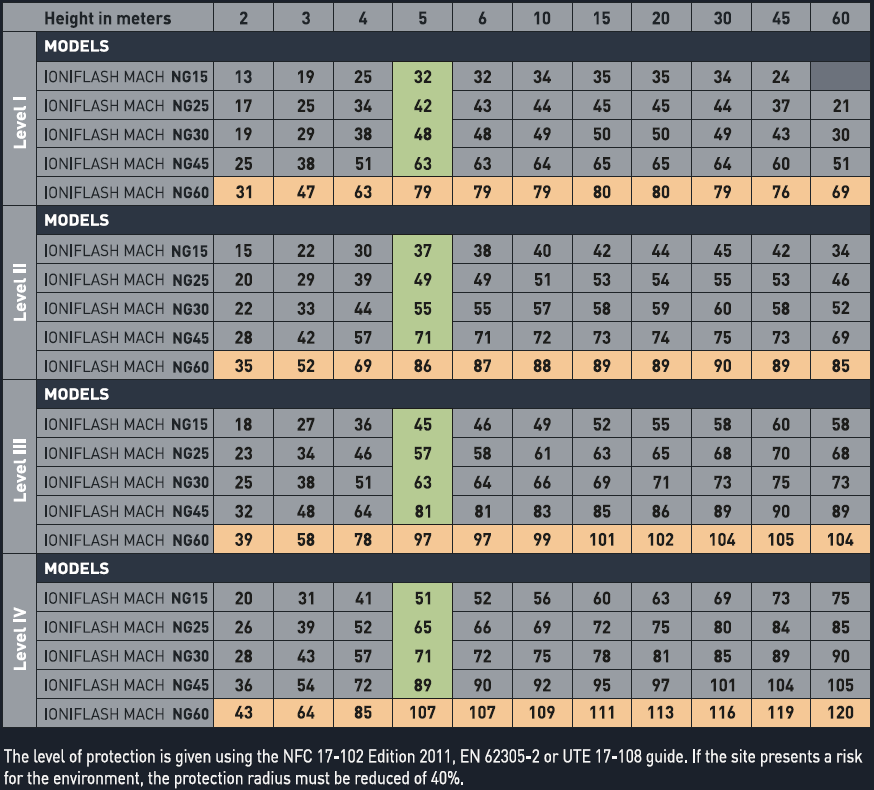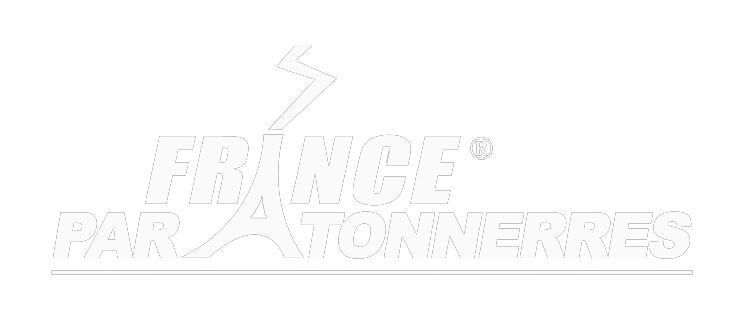France Paratonnerres, 100% French specialist of lightning protection, answers to the most frequently asked questions about lightning :
Questions about lightning:
During strong contrasts in temperatures (heat waves) very particular clouds appear: cumulonimbus.
In these clouds (which can rise many km), important updrafts produce many water and ice. The mixing inside these clouds produce electrical charges which gather in different locations. The positive charges being up, and negative charges being down.
When the dielectric strength of the space between up and down is not sufficient anymore, an emission produces (a huge spark). The lightning is the visible representation of this emission. This is a very violent and short electrical discharge, passing through the space between cloud and ground.
The lightning strikes are discharges appearing between the clouds. France is impacted each year between 1 and 2 million times by lightning, depending on the meteorological conditions. This frequency depends from a location to another.
Discover our E.S.E. air terminals
There is 2 types of lightning strikes : Upwards and downwards, defined by the direction of the leader (initiation of the lightning, preparing the way until the lightning)
The names of the cloud-to-ground lightning flashes depend on the polarity and orientation of the first leader.
So, we have :
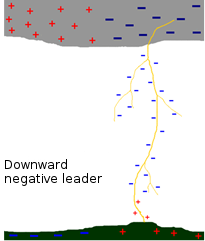
The downward negative leader comes from a downward leader from negative layer in lightning cloud, spreading to the ground with 70 to 1200 km/s velocity.
Nearby, an upward leader is generated. When they meet, the discharge occurs by electrons transfer from the cloud to the ground. These are the most common type.
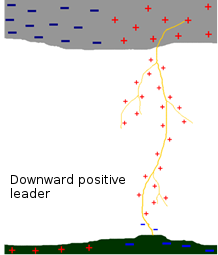
The upward negative leader comes from an upward negative charge. This upward leader travels from 80 to 460 km/s velocity.
As for all upward charges, it starts from a sharp of the ground (mountain, telecommunication tower,…) and spreads until a cloud area charged positively. With low distance, a downward leader is generated from a cloud. When the contact is made, the positive charges are transferred from the cloud to the ground.
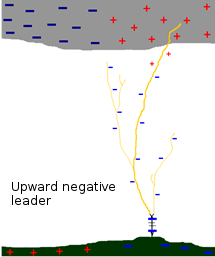
Le coup de foudre ascendant négatif provient d’une charge ascendante négative. Ce traceur ascendant voyage à une vitesse voisine de 80 à 460 km/s. Comme toutes les charges ascendantes, il débute à partir d’une aspérité au niveau du sol (montagne, antenne de télécommunication,…) et se propage vers une zone du nuage chargée positivement. A faible distance, un traceur descendant est émis à partir du nuage.
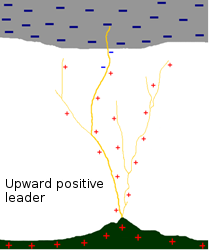
The upward positive leader starts from an upward leader moving with 40 to 70 km/s velocity near the ground, and which can reach until 1000 km/s altitude.
This leader comes from an upward positive leader from the ground. These leaders will spread until the base of the cloud positively charged. When approaching, the discharge occurs and the electrons are transferred from the cloud to the ground.
Discover our E.S.E. Air Terminals
The specific sound of the thunder comes from the rise of the pressure with electrodynamic origin. This overpressure disappears when the strike is off, producing an acoustic shockwave. The acoustic strength and intensity depends on the form, the length, the intensity and shortness of the lightning strike.
Interesting thought. Some scientists have studied the question. But for the moment, there is no solution to recover this energy, or to store it afterwards. A lightning discharge lasts about half a second, which makes its use even more complicated.
Questions about lightning protection:
5 steps must be done to ensure an efficient lightning protection. In this context, the Engineering department of France Paratonnerres can follow you up during each step:
- Lightning Risk Analysis (ARF): Assessment of the elements to be protected.
- Technical Study: (ET): detailed preventive measures and protection devices to implement.
- Material supply: Direct and indirect lightning protection.
- Installation: installation of the material, in conformity with the technical study, and with qualified and partners network
- Periodical maintenance: Initial verification by a third party, maintenance and annual verification of the installed protections.
In France, the installations classified for environment called “ICPE” in France are industrial, tertiary or agricultural (production factory, water treatment plant, workshops, storage buildings, hospitals…) likely to present some risks or to generate pollution or damages for neighbourhood health, patrimony, and environment. The person in charge of a classified site must implement the lightning risk analysis (according to NFC 17-102 and EN 62305-2) for its site, if it is required in one of the sections designated in Ministerial order of July 19th 2011.
The level of protection is determined according to several criterias, including the size of the building, the storm activity of the area, the use of the building, the number of connected services, the location, the environment around the building, etc…
To help you determine the required level of protection for your building, tools exist.
Download for free IONEXPERT 4000, our lightning risk analysis software.
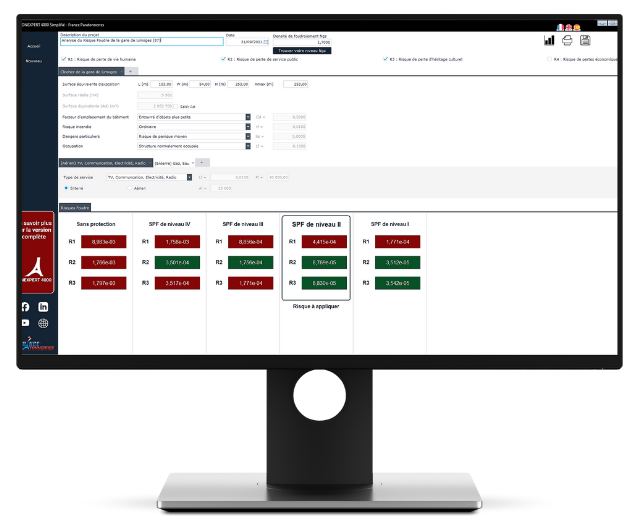
The keraunic level is the number of days per year when thunder has been heard in a defined area. The French departments have been separated in 2 categories: Keraunic level less or equal to 25, and keraunic level over 25.
The keraunic level (Nk) corresponds to the strikes number and, more precisely, the number of thunders heard in a defined area.
The lightning density (Ng) is the number of lightning impacts per km² and per year.
The density of the touching points of the lightning onto the ground (Nsg) is the average number of lightning strikes onto the ground per km² and per year.
It is estimated that lightning strikes about 1 time out on 10 thunders heard. So Nk (Keraunic level) =10Ng
Below is the French map of the density of the touching points of the lightning onto the ground (Nsg) from the NF C 17-102 (2011) standard according to the data supplied by Météorage :
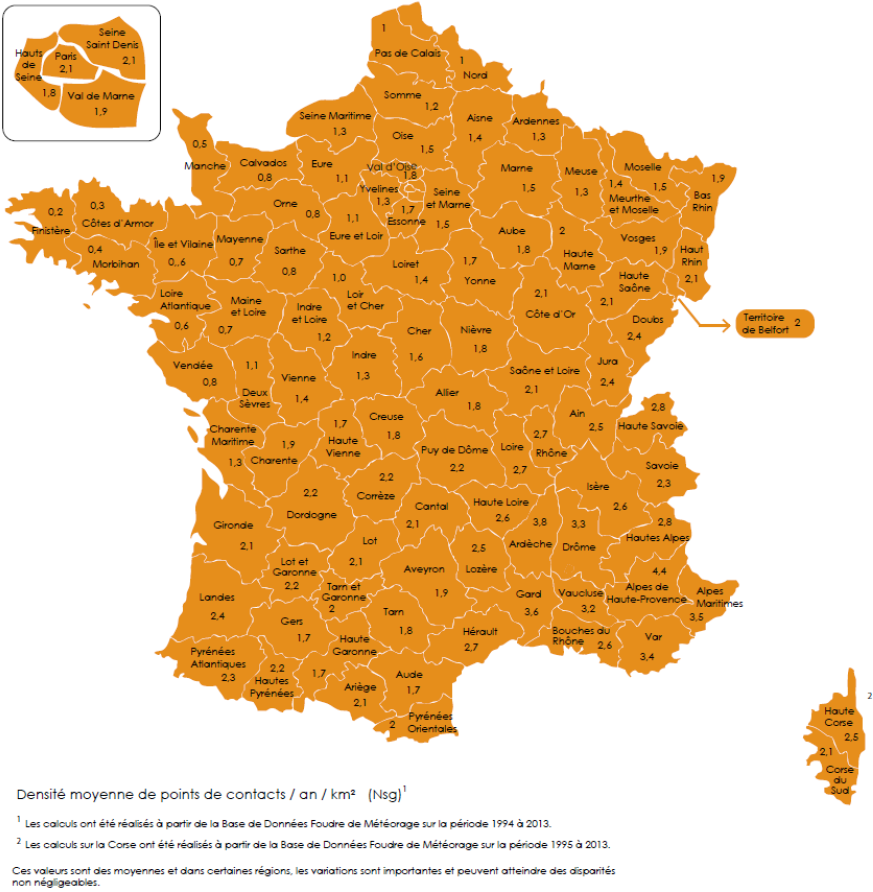
Below is a world map showing the lightning density (Ng) measured by the NASA :
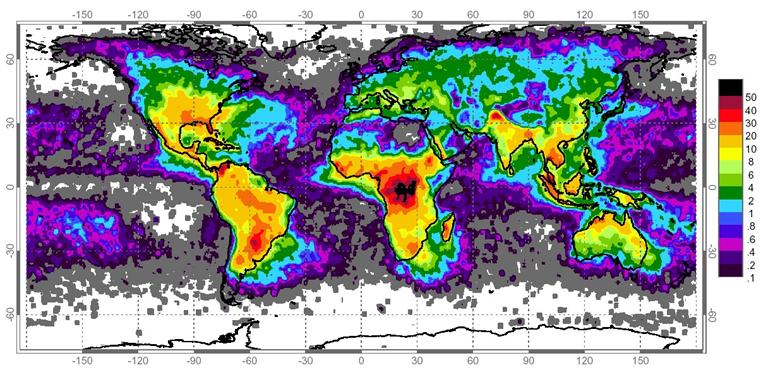
Questions about lightning protection products:
The air terminals are dedicated to protect a building from direct impacts by moving the atmospherical discharges until the ground. The principle consists in creating one or several preferential impacts points of Lightning, with low impedance conductive elements, and then, to spread and dissipate the lightning current in the ground.
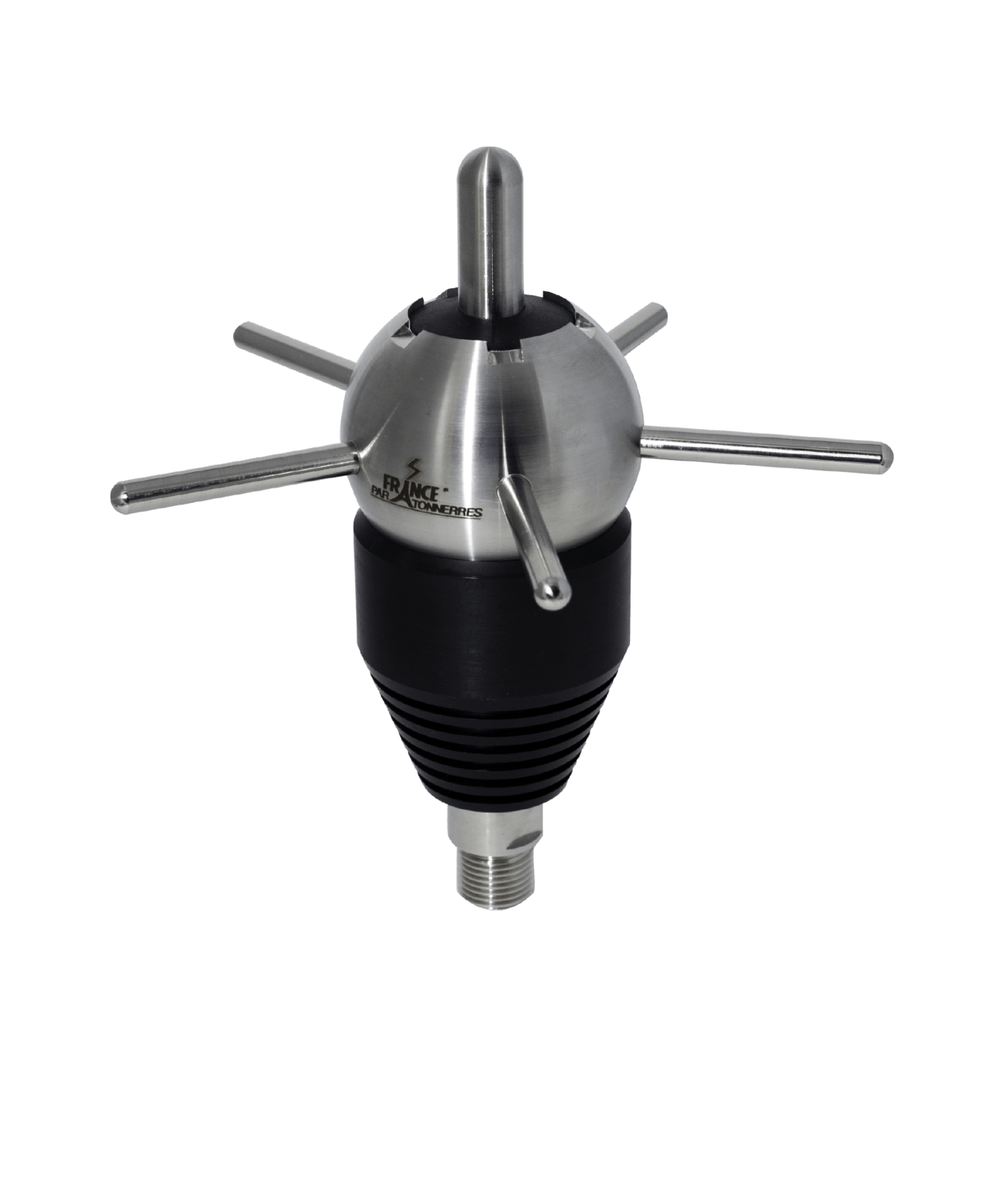
As a complement, the Surge Protector Device ensures the internal protection of the building, for the overvoltages with high amplitude damaging or destroying the installations, the electronic and electric devices. It will enable to limit the voltage by deviating it until the earth of the building.

A surge protector is an electronical protection apparatus, acting like a variable impedance, depending on the tension at its poles :
In normal functioning (no lightning impact), the SPD is acting like an opened circuit for the rest of the installation.
At the time of a lightning impact, the SPD becomes a passing element (closed circuit) (important and quick rise of the voltage). The SPD is acting dually: making the overcurrent flow and limiting the overvoltage.
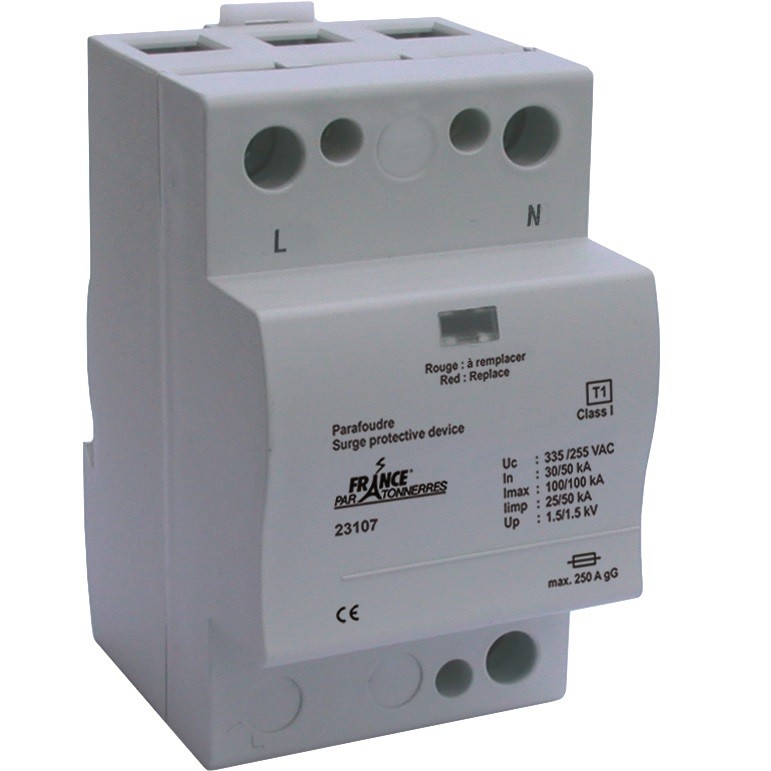
The SPDS are classified as follow :
- Type 1 SPD (named equipotentiality SPD) must be placed in the main electrical panel, entering in the installation. It can deviate the direct energy of a lightning impact. It enables to flow the return current spreading from the earthing conductor until network conductors. The type 1 SPDs have a 10/350 µs wave. The NF C 15-100 standard (ed. 2002) makes compulsory the type 1 SPDs in lightning protection installations.
- Type 2 SPDs is the main protection for all electrical low voltage installations. Installed in each electrical panel, it avoids the overvoltages in electrical installations and protects the receivers. The type 2 SPDs have a 8/20 µs wave.
- Type 3 SPDs have a low flow capacity. So it is compulsory to install it as a complement of type 2 SPDs, near sensitive receivers. Type 3 SPDs have a combination of 1.2/50 µs voltage wave and 8/20 µs current wave.
Discover our surge arresters
Discover our range of E.S.E. Air Terminal
- Simple Rod air terminal
- Meshed cage air terminal
- Catenary wires
- Early Streamer Emission air terminal (ESE)
The Simple Rod air terminal is composed from a metallic rod with 2 to 8 m height dominating the structure to protect, and linked to 2 down conductors minimum, and 2 earthing systems. The protection radius ensured by this air terminal which is limited to 30 m more or less (Protection level IV, height = 60 m), especially dedicated to the protection of small structures or areas like towers, chimneys, tanks, water tower, antenna masts… The EN 62305-3 standard describes the installation procedure for these air terminals.
13 Simple Rods, 13 down conductors, and 13 earthing systems are necessary to ensure the protection below :
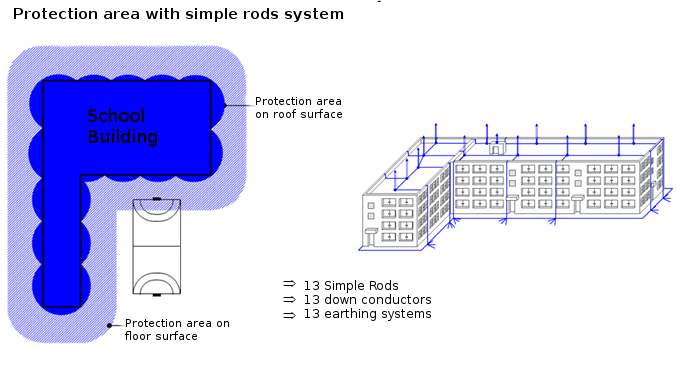
The catenary wires protection is a method closed to the meshed cage principle, because it is constituted with meshing of the conductors far from the structure to protect, to avoid any contact with lightning current.
Catenary wires are located over the structure to protect, connected to down conductors and specific earthing systems. The width of the meshing and distance between the down conductors must respect the same rules as for the meshed cage. The EN 62305-3 describes the installation procedure for this method.
Generally, this method is heavy and expensive, due to the complexity of the structures to protect.
26 capture points, 26 down conductors and a grounded loop earthing system are necessaries to ensure the protection of the structure here below :
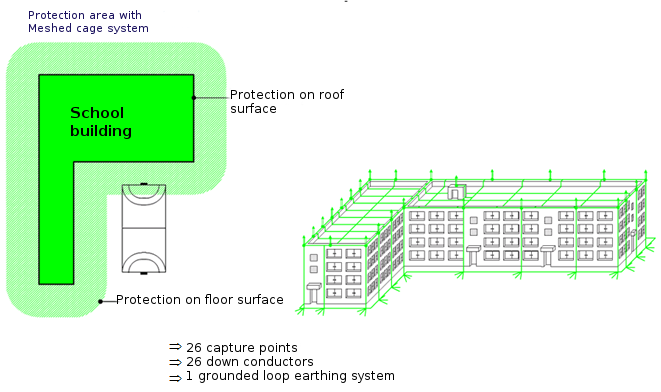
The catenary wires protection is a method closed to the meshed cage principle, because it is constituted with meshing of the conductors far from the structure to protect, to avoid any contact with lightning current.
Catenary wires are located over the structure to protect, connected to down conductors and specific earthing systems. The width of the meshing and distance between the down conductors must respect the same rules as for the meshed cage. The EN 62305-3 describes the installation procedure for this method.
Generally, this method is heavy and expensive, due to the complexity of the structures to protect.
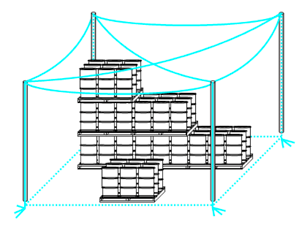
The ESE air terminal is a terminal which enables to generate artificially an upward leader earlier than a simple rod, with an ionization system, in order to establish a special impact on its point. The capture of the lightning strike being faster than a simple rod, this technology enables to benefit from larger protection areas, ensuring protection for large dimensions structures.
The generated protection radius depends on the early streamer emission value of the air terminal (Δt in µs), its height, and the efficiency of the protection. The protection radius ensured by this type of air terminal is 120 m (Protection level IV, height = 60 m , early streamer emission time 60µs) The NFC 17-102 standard describes the installation procedure for this type of air terminal.
The installation of this type of air terminal is easy and cheaper than other technologies. It can protect whole buildings with one E.S.E. air terminal. It enables the protection of a structure and its environment, the protection of opened areas and well integrate in the architecture of a structure without aesthetic alteration.
1 ESE, 2 down conductors and 2 earthing systems are necessary to ensure the protection below :
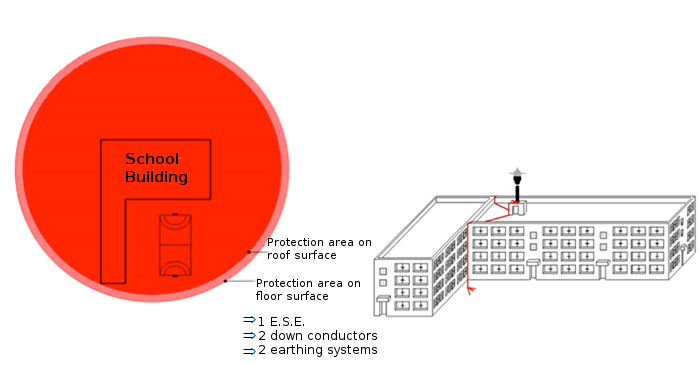
Discover our range of E.S.E. Air Terminal
The Early Streamer Emission of an ESE Air Terminal (ESEAT) designates the time saving measured in laboratory compared to a simple lightning rod, the greater the streamer emission, the greater the effectiveness of the ESEAT.
Our range IONIFLASH MACH NG is composed of five ESEAT, with five different streamer emission: 15µs / 25µs / 30µs / 45µs / 60µs.

The protection radius of an Early Streamer Emission Air Terminal (ESEAT) depends on its efficiency, the height at which it is installed compared to the surface to protect, and the level of protection chosen according to the calculation formula extracted from the NF C 17-102 standard, edition 2011.
The protection radius is established from 2m under the tip of the ESEAT.
Protecion radius of our ESEAT IONIFLASH MACH NG are summarized in the following table:
